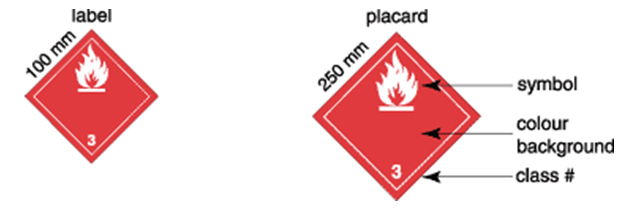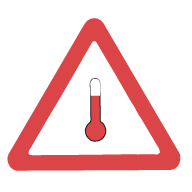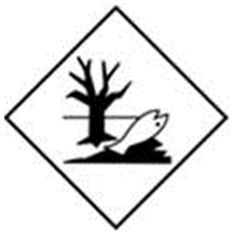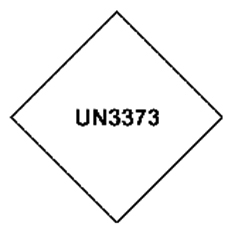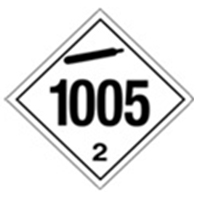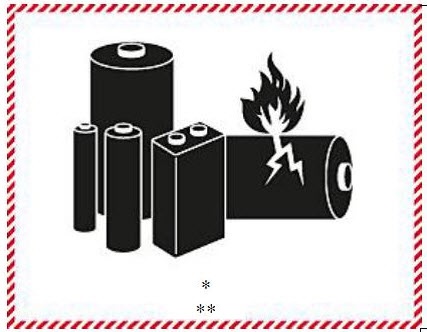This bulletin explains the labelling and placarding requirements. It does not change, create, amend or suggest deviations to the Transportation of Dangerous Goods Regulations (TDG Regulations). For specific details, consult Part 4 of the TDG Regulations.
The term “dangerous goods safety mark” is replaced with “dangerous goods mark” throughout the English version of the TDG Regulations and this document to reflect the terminology being used in the Act. This change will allow internal consistency with no change in the meaning. The terminology in the TDG Regulations is being modified as the TDG Regulations are updated.
On this page
- Overview
- Consignor and carrier responsibilities
- General requirements
- Misleading dangerous goods marks
- Labels
- Placards
- When and how to display placards
- Other dangerous goods marks to display on a large means of containment
- DANGER placard
- Exemption for dangerous goods with a gross mass of 500 kg or less
- Display dangerous goods marks on a compartmentalized large means of containment
- Voluntarily display of placards for any quantity of dangerous goods
- Other dangerous goods marks
- Air, marine, U.S. (road/rail) shipments
- Compliance with the TDG Act and Regulations
- Contact us
Overview
Part 4 of the TDG Regulations requires dangerous goods mark to be displayed on a means of containment containing dangerous goods in transport.
A dangerous goods mark can be a label, placard, orange panel, sign, mark, letter, word, number or abbreviation, or any combination of these things.
Dangerous goods marks are displayed on a means of containment to identify dangerous goods and to show the nature of the danger they pose.
Dangerous goods marks give a quick identification of dangerous goods in the event of an emergency situation such as a release or anticipated release of dangerous goods from a means of containment.
Dangerous goods marks are also an information tool for people involved in transportation, including truck drivers, train crews, loading dock workers, reception personnel at a lab or a hospital and aircraft loading personnel.
Generally, labels are displayed on small means of containment (capacity less than or equal to 450 L) and placards are displayed on large means of containment (capacity greater than 450 L). For example, labels would be displayed on a box, while a placard would be displayed on a truck carrying the box.
This Bulletin has been divided into eight parts:
- Consignor and carrier responsibilities
- General requirements
- Misleading dangerous goods marks
- Labels
- Placards
- Other dangerous goods marks – Marks and signs
- International shipments
- Contact information
Consignor and carrier responsibilities
Consignor responsibilities
Before importing dangerous goods, or allowing a carrier in Canada to take possession of dangerous goods for transport, the consignor must:
- display or ensure the display of the required dangerous goods marks on each small and large means of containment that contain dangerous goods
- provide the carrier with the dangerous goods marks for the dangerous goods that the consignor is offering for transport or importing and that are to be transported in a large means of containment
Exception: The consignor is not required to provide the dangerous goods marks if the correct marks are already displayed on the large means of containment, or the marks are not the correct ones to display because of the presence of other dangerous goods in the large means of containment.
Typically, when the consignor provides the large means of containment, the consignor is responsible for displaying the dangerous goods marks. However, if the carrier provides the large means of containment, the consignor must provide the carrier with the appropriate dangerous goods marks and the carrier will then display them.
Note: A consignor means a person in Canada who is named in a shipping document as the consignor, or who imports or will import dangerous goods into Canada, or, if neither of the first two points apply, who has possession of dangerous goods immediately before they are in transport.
Carrier responsibilities
As a carrier, you are the person who has possession of the dangerous goods while they are in transport. With respect to dangerous goods marks, the carrier must:
- display the required dangerous goods marks on the large means of containment, unless they are already displayed on it
- ensure that the required dangerous goods marks remain displayed on the small and large means of containment while the dangerous goods are in transport
- provide and display, or remove, the dangerous goods marks if the requirements for the dangerous goods marks change while the dangerous goods are in transport.
Responsibility of removing or changing dangerous goods marks
When the conditions that required the display of dangerous goods marks change, the person having the charge, management or control of the means of containment must determine whether the dangerous goods marks must be changed or removed.
In addition, the person who neutralizes the contents of the means of containment or who unloads, unpacks, cleans or purges the means of containment must cover or remove the dangerous goods marks when the danger is no longer present in the means of containment.
Note: When the DANGER placard is permitted to be displayed on a large means of containment, a person may continue to display that placard, in place of any other placard, until the large means of containment no longer contains any of the dangerous goods identified by that placard. The use of the DANGER placard is explained below.
General requirements
General requirements for dangerous goods marks
Dangerous goods marks must be:
- visible*
- legible
- displayed against a background of contrasting colour
- made of durable, weather-resistant material that will resist detachment or deterioration in the conditions they will be exposed to
- displayed in the appropriate colour as indicated in Section 4.6 of the TDG Regulations (dangerous goods marks must not be faded)
*In accordance with Section 4.15.4 of the TDG Regulations, when a large means of containment with dangerous goods marks is inside another large means of containment and those dangerous goods marks are not visible, the placards and UN numbers required in Part 4 must be displayed on the outer large means of containment.
Orientation and size of labels and placards
Labels and placards are diamond shaped (also referred to as a square on point) and must be displayed as illustrated below. They are often identical (except for their size) and they communicate through colour, number and symbol the degree and nature of danger posed by the dangerous goods.
If that size placard cannot be displayed due of the size or irregular shape of certain means of containment, the TDG Regulations allow for the reduction of labels to 30 mm per side and placards to 100 mm per side. The only exception is for Class 7, Radioactive Materials, whose placard and label cannot be reduced under any circumstances.
Misleading dangerous goods marks
Dangerous goods mark considered to be misleading
A person must not display a prescribed dangerous goods mark on a means of containment or a means of transport if the mark is misleading as to the presence or the nature of any danger.
Displaying a dangerous goods mark when no dangerous goods are present is misleading as to the presence of danger.
Displaying a dangerous goods mark that does not represent the class of dangerous goods is misleading as to the nature of danger.
For example, Class 3, Flammable Liquids placards on a road vehicle transporting METHYL CHLORIDE would be considered misleading as to the nature of danger, since this product is classified under Class 2.1, Flammable Gases.
In addition, a person must not display any othermark that could be mistaken for a dangerous goods mark or could be misleading as to the presence or nature of any danger.
Labels
When and how to display labels
A label must always be displayed on a small means of containment containing dangerous goods in transport. One label is required for the primary class, as well as one for each subsidiary class of the dangerous goods.
Labels for the primary and subsidiary classes can be displayed on any side, except the top or bottom, of a small means of containment, and on the shoulder of cylinders. A package containing Class 7, Radioactive Materials must display a label on two opposite sides other than the side it is intended to rest or is to be stacked.
Exceptions to this basic labeling rule can be found in Section 4.10 of the TDG Regulations.
Other dangerous goods marks to be displayed on a small means of containment
Aside from labels, a small means of containment must also display the shipping name, technical name (if applicable) and UN number of the dangerous goods in transport. The UN number may appear on or next to the primary class label (see image below).
Except for dangerous goods included in Class 7, Radioactive Materials, if that size label cannot be displayed because of the irregular shape or size of the small means of containment, the TDG Regulations allow for the reduction of a label to 30 mm. The label, shipping name, technical name and UN number may appear on a tag.
Note: There are some additional requirements for Class 7, Radioactive Materials. These can be found in Section 4.14 of the TDG Regulations.
Overpack label
An overpack is defined as an enclosure used by one consignor to consolidate one or more small means of containment for ease of handling. An example of an overpack is a pallet on which one or more small means of containment are stacked and secured by straps or shrink wrap or other similar means.
If a dangerous goods mark for each class of dangerous goods inside the overpack is not visible through the overpack, the word “Overpack” or “Suremballage” must be displayed on at least one side. However, if all dangerous goods marks for each class of dangerous goods inside the overpack are visible through the overpack, the word “Overpack” or “Suremballage” is not required.
If the dangerous goods marks are not visible through the overpack, the primary class label and each subsidiary class label for each of the dangerous goods, as well as the shipping name and UN number, must be displayed on the overpack. Also, depending on the size of the overpack, this information is required on either one or two opposite sides.
Note: When the overpack contains Class 7, Radioactive Materials, the overpack must be prepared in accordance with the Packaging and Transport of Nuclear Substances Regulations.
Label on a consolidation bin
A consolidation bin is used in a road vehicle to secure one or more small means of containment to prevent movement during transport. Unlike an overpack, a consolidation bin allows users to add or remove small means of containment during transport. A typical user of consolidation bins would be a delivery service that makes many deliveries in one route.
When a consolidation bin is used, the class of each dangerous good contained in the bin must be marked on a tag or on a fixed display device that is attached to the bin. The information must be updated whenever the content of the consolidation bin changes.
Placards
When and how to display placards
As per Section 4.15 of the TDG Regulations, the primary class placard for each dangerous good contained in a large means of containment must be displayed on each side and on each end of the large means of containment. Each placard only needs to be displayed once on each side and each end regardless of how many products in the large means of containment correspond to that class (primary or subsidiary).
For example, if a vehicle is transporting UN1833, SULFUROUS ACID (Class 8) and UN1836, THIONYL CHLORIDE (Class 8), only one Class 8, Corrosives placard is required to be displayed on each side and on each end of the vehicle.
A subsidiary class placard is required to be displayed on a large means of containment for dangerous goods that requires an emergency response assistance plan (ERAP) if they are included in one of the following subsidiary class:
- Class 1, Explosives
- Class 4.3, Water-Reactive Substances
- Class 6.1, Toxic Substances, Packing Group I due to toxic inhalation toxicity
- Class 8, Corrosives and are UN2977 or UN2978
The subsidiary class placard must be displayed next to the primary class placard on each side and on each end of the large means of containment:
Note: A placard must not be displayed at a 45 degree angle on a truck frame or a supporting frame for the means of containment; it must remain as a square on point. Otherwise, this does not comply with the TDG Regulations.
Other dangerous goods marks to display on a large means of containment
Aside from placards, a large means of containment must also display the UN number of the dangerous goods if:
- an ERAP is required
- it is a liquid or gas in direct contact with the large means of containment. For example, a highway tank transporting UN1203, Gasoline. The liquid (gasoline) is in contact with the tank (large means of containment)
The UN number must appear on the placard or on a rectangular orange panel, without the prefix "UN", next to the placard (see image below).
DANGER placard
The DANGER placard is optional. It may be displayed on a large means of containment instead of any other placard required by Section 4.15 of the TDG Regulations if two conditions are met:
- the large means of containment contains two or more dangerous goods that require different placards
- the dangerous goods loaded into the large means of containment are contained in two or more small means of containment
However, there are exceptions to this rule. The DANGER placard cannot be displayed on a large means of containment if:
- the dangerous goods have a gross mass greater than 1,000 kg, are included in the same class and are offered for transport by one consignor
- the dangerous goods require an emergency response assistance plan (ERAP)
- the dangerous goods are included in one of the following classes:
- Class 1, Explosives
- Class 2.3, Toxic Gases
- Class 4.3, Water-reactive Substances
- Class 5.2, Organic Peroxides, Type B
- Class 6.1, Toxic Substances (subject to Special Provision 23)
- Class 7, Radioactive Materials, Category III – Yellow label
Note: If a road or railway vehicle to be transported by vessel contains a flammable gas, the flammable gas placard (Class 2.1) must be displayed on the road or railway vehicle.
Exemption for dangerous goods with a gross mass of 500 kg or less
Section 4.16.1 of the TDG Regulations provides an exemption from displaying placards on a road or railway vehicle if the dangerous goods have a gross mass that is less than or equal to 500 kg. You always have the option, however, to display placards for small quantities of dangerous goods voluntarily.
This exemption, however, does not apply if the dangerous goods:
- require an emergency response assistance plan (ERAP)
- require the display of a subsidiary class placard
- are included in the following classes:
- Class 1, Explosives (see exceptions in paragraph 4.16.1(2)(c))
- Class 2.1, Flammable Gases, if the road or railway vehicle is to be transported by vessel
- Class 2.3, Toxic Gases
- Class 4.3, Water-reactive Substances
- Class 5.2, Organic Peroxides, Type B that require a control or emergency temperature
- Class 6.1, Toxic Substances (subject to Special Provision 23)
- Class 7, Radioactive Materials, Category III – Yellow label
For example, if a road vehicle is transporting 400 kg of UN1090, ACETONE, Class 3 placards do not need to be displayed since there is less than 500 kg in transport and none of the restrictions apply.
However, if a vehicle is transporting a mixed load of dangerous goods, each class of dangerous good must be considered separately. In the following example, a road vehicle is transporting 2,000 kg of UN1048, HYDROGEN BROMIDE, ANHYDROUS (Class 2.3(8)) and 300 kg of UN1107, AMYL CHLORIDE (Class 3). Since UN1048 meets one of the restrictions listed in Subsection 4.16.1(2), a Class 2.3 placard must be displayed. As such, the quantity of UN1048 must no longer be considered in the total gross mass calculation of the dangerous goods in transport. All that remains is 300 kg of UN1107, which doesn’t meet any restrictions and weighs less than 500 kg. For this reason, a Class 3 placard does not need to be displayed.
Display dangerous goods marks on a compartmentalized large means of containment
There are different requirements for displaying dangerous goods marks on a compartmentalized large means of containment. It depends on if the dangerous goods are included in different primary classes or in the same primary class.
Different Primary Classes
If the dangerous goods are included in different primary classes, the primary class placard and the UN number for the dangerous goods in each compartment must be displayed on each side of that compartment, as well as on each end of the compartmentalized large means of containment.
Same Primary Class
If the dangerous goods are included in the same primary class, the primary class placard for the dangerous goods must be displayed only once on each side and on each end of the compartmentalized large means of containment. The UN number must also be displayed on each side of the compartment and on each end of the compartmentalized large means of containment.
However, when all of the dangerous goods are included in Class 3, Flammable Liquids, only the UN number of the dangerous goods with the lowest flash point is required to be displayed on each side and on each end of the compartmentalized large means of containment.
In addition, if the compartmentalized large means of containment contains UN3475, ETHANOL AND GASOLINE MIXTURE, the UN number must be displayed, along with the UN number of the dangerous goods with the lowest flash point, on each side and on each end of the compartmentalized large means of containment (see image below).
Note that the UN number on a large means of containment must appear on the placard, or on a rectangular orange panel next to the placard, without the prefix "UN".
Voluntarily display of placards for any quantity of dangerous goods
Despite the fact that a placarding exemption may be used, a person may voluntarily display a placard for any quantity of dangerous goods when they are transported in a road or railway vehicle if certain provisions of Part 4 are met. These provisions include:
- Section 4.2 – Misleading Dangerous Goods Safety Marks
- Section 4.6 – Visibility, Legibility and Colour
- Section 4.7 – Labels and Placards: Size and Orientation
- Subsection 4.9(2) – Removal or Change of Dangerous Goods Safety Marks
- Section 4.14 – Class 7, Radioactive Material
- Section 4.15.1 – Subsidiary Class Placards on a Large Means of Containment
- Paragraphs 4.15.3(a) and (b) – Placards and UN Numbers on a Large Means of Containment
- Section 4.16 – DANGER Placard
All of the above provisions must bemet in order to voluntarily display a placard.
Other dangerous goods marks
Other dangerous goods marks and signs may be required when transporting certain dangerous goods.
Elevated temperature sign
The elevated temperature sign must be displayed next to the primary or subsidiary class placard on each side and each end of the large means of containment when dangerous goods are transported at a temperature greater than or equal to:
- 100°C if the dangerous goods are in a liquid state
- 240°C if the dangerous goods are in a solid state
The sign is an equilateral triangle with sides of at least 250 mm in length. The symbol is a thermometer, and the symbol and border are red on a white background.
Fumigation sign
When dangerous goods are used to fumigate a large means of containment, the fumigation sign must be displayed at or next to each entryway through which a person can enter the large means of containment.
The consignor must ensure that the fumigation sign is displayed by the person in charge of the fumigation process. The sign must also display the name of the fumigant, the date and time the fumigant was applied and the date of ventilation.
The fumigation sign must be displayed until the large means of containment has been ventilated and the dangerous goods have been unloaded.
Marine pollutant mark
As required by Subsection 4.22(1), the marine pollutant mark must be displayed for dangerous goods that are marine pollutants and transported by vessel. This mark is not required for road and rail transport. For air transport, please refer to Part 12 of the TDG Regulations.
Category B mark
The Category B mark must be displayed on a small means of containment containing UN3373, BIOLOGICAL SUBSTANCE, CATEGORY B, instead of displaying the Class 6.2, Infectious Substances label.
Inhalation hazard
When dangerous goods are subject to Special Provision 23 or are included in Class 6.1, Toxic Substances, due to inhalation toxicity or Class 2.3, Toxic Gases, the words “inhalation hazard” or “dangereux par inhalation” must be displayed on the means of containment:
- in the case of a small means of containment, in letters 12 mm high, next to the shipping name, unless these words are already part of the shipping name
- in the case of a large means of containment, on two opposite sides of the large means of containment, in addition to any placard or placard and UN number required by Part 4, in letters:
- at least 6 mm wide and 100 mm high in the case of a tank car
- at least 4 mm wide and 25 mm high in the case of a portable tank or an intermediate bulk container (IBC)
- at least 6 mm wide and 50 mm high in the case of all other large means of containment
Anhydrous ammonia
When UN1005, ANHYDROUS AMMONIA is transported in a large means of containment, there are two placarding options:
- display the Class 2.3 placard and the UN number
- display the Anhydrous Ammonia placard and, on at least two sides, the words “Anhydrous Ammonia, Inhalation Hazard” or “Ammoniac anhydre, dangereux par inhalation” in letters:
- at least 6 mm wide and 100 mm high in the case of a tank car
- at least 4 mm wide and 25 mm high in the case of a portable tank
- least 6 mm wide and 50 mm high in the case of all other large means of containment
OR
ANHYDROUS AMMONIA,
INHALATION HAZARD
Note: In accordance with Paragraph 4.6(a), dangerous goods marks must be displayed against a background of contrasting colour. However, since the placard, as well as the means of containment used for ANHYDROUS AMMONIA may both be white, the metal frame of the placard holder is deemed to be of contrasting colour.
Limited quantities mark
When complying with the Limited Quantities Exemption (Section 1.17), the limited quantities mark must be displayed on one side of a means of containment (as per Subsection 1.17(2)).
Note: Until December 31, 2020, instead of displaying one of the above marks, the means of containment may be marked with the words: “Limited Quantity”, “Ltd. Qty.”, “Consumer Commodity” or the UN number of each limited quantities of the dangerous goods in a square on point.
Excepted quantities mark
When complying with the Excepted Quantities Exemption (Section 1.17.1), the excepted quantities mark must be displayed on one side of a means of containment (as per Subsection 1.17.1(3)).
* Replace with the primary class
** Replace with the name of the consignor or the consignee
Lithium battery mark
When complying with Special Provision 34 of the TDG Regulations, each means of containment must be marked with the lithium battery mark in accordance with Section 4.24 of the TDG Regulations.
*Replace with UN number(s)
** Replace with telephone number for additional information
Note: CANUTEC’s telephone number cannot be used on the lithium battery mark.
For more information on the lithium battery mark requirements and the lithium battery exemption, refer to Section 4.24 and Special Provision 34 of the TDG Regulations.
Air, marine, U.S. (road/rail) shipments
In specific cases, the TDG Regulations allow the use of dangerous goods marks in accordance with other regulations. Refer to Parts 9, 10, 11 and 12 for more information.
For air shipments please refer to Part 12 of the TDG Regulations.
For marine shipments, please refer to Part 11 of the TDG Regulations.
For shipments originating from the U.S. (road and rail), please refer to Part 9 and 10 of the TDG Regulations.
Compliance with the TDG Act and Regulations
Failure to comply with the TDG Act and TDG Regulations may lead to fines and/or imprisonment. For more information, you can visit the TDG website and the Department of Justice website.
Contact us
For regulatory questions, contact the TDG regional office in your region:
Atlantic
1-866-814-1477
TDG-TMDAtlantic@tc.gc.ca
Quebec
1-514-633-3400
TMD-TDG.Quebec@tc.gc.ca
Ontario
1-416-973-1868
TDG-TMDOntario@tc.gc.ca
Prairie & Northern
1-888-463-0521
pnrtdg-tmdrpn@tc.gc.ca
Pacific
1-604-666-2955
TDGPacific-TMDPacifique@tc.gc.ca
Dangerous goods marks
(PDF, 1.1 MB)

